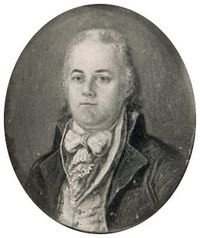- About MAA
- Membership
- MAA Publications
- Periodicals
- Blogs
- MAA Book Series
- MAA Press (an imprint of the AMS)
- MAA Notes
- MAA Reviews
- Mathematical Communication
- Information for Libraries
- Author Resources
- Advertise with MAA
- Meetings
- Competitions
- Programs
- Communities
- MAA Sections
- SIGMAA
- MAA Connect
- Students
- MAA Awards
- Awards Booklets
- Writing Awards
- Teaching Awards
- Service Awards
- Research Awards
- Lecture Awards
- Putnam Competition Individual and Team Winners
- D. E. Shaw Group AMC 8 Awards & Certificates
- Maryam Mirzakhani AMC 10 A Awards & Certificates
- Two Sigma AMC 10 B Awards & Certificates
- Jane Street AMC 12 A Awards & Certificates
- Akamai AMC 12 B Awards & Certificates
- High School Teachers
- News
You are here
Mathematics Education at West Point: The First Hundred Years - Andrew Ellicott
Andrew Ellicott (1754-1820) was professor of mathematics from 1813 until his death in 1820 and used Hutton. At this time each department had only one professor and several instructors, thus to be the “Professor of Mathematics” meant to be the department head. He had the reputation as a good teacher, and it appears that under his leadership, the teaching of mathematics was much less tied to the text. Ellicott was a kindly and friendly man who was well liked by the cadets for he was full of interesting stories. They nicknamed him “Old Infinite Series,” revealing that the topic was indeed taught to the Corps. He was famous for the perfect geometrical constructions that he made at the blackboard with cord and straightedge. He even had a small slate and sponge attached to his buttonhole.

Andrew Ellicott
Here is how Ellicott was described by Cadet E. D. Mansfield, the son of Jared Mansfield, professor of mathematics at the Academy from 1817 to 1828:
There are some who will recollect Professor Ellicott sitting at his desk at the end of a long room, in the second story of what was called the Mess Hall, teaching geometry and algebra, looking and acting precisely like the old-fashioned school-master, of whom it was written,
“And still they gazed, and still the wonder grew
That one small head could carry all he knew.”
In the other end of the room, or in the next room, was his acting assistant, Stephen H. Long. * * * The text-book used was Hutton’s Mathematics, and at that time the best to be had. * * * It was a good text book then, for there were no cadets trained to pursue deeper or more analytic works.[1]
In a letter to Joseph G. Swift, the first USMA graduate (1802) and Superintendent from 1812 to 1814, dated 10 February 1815, Ellicott writes that they have kept 80 cadets together for vacation. “[T]hey have made great progress, --- these classes are in Conic sections, one of which will be in fluxions before the end of the next month.”[2] This is the earliest reference to the teaching of calculus at USMA that we have found. Whether it was actually taught as a class, or as a seminar, and precisely what was taught is unknown.
The earliest record of teaching calculus at West Point dates from 1810. During the winter vacation Alden Partridge tutored Alexander Williams, the son of the first Superintendent, Jonathan Williams, in calculus.[3] The first record of a class being taught in calculus at West Point is in the fall of 1815 when Professor Andrew Ellicott examined seven cadets in the subject.[4] Curiously, although Charles Davies graduated with this group in December 1815, his name is not on the list. Davies likely learned calculus earlier from Ellicott or Partridge. Cajori comments that:
At West Point, during the first few years of its existence, neither fluxions nor calculus received much attention. As late as 1816 it is stated in the West Point curriculum that fluxions were “to be taught at the option of professor and student.” In 1817, Claude Crozet, trained at the Polytechnic School in Paris, became teacher of engineering. A few times, at least, he used in print the Newtonian notation, as for instance, in the solution, written in French, of a problem which he published in the Portico, of Baltimore, in 1817.[5]
By 1825 all cadets were learning some calculus.
[1]Quoted in Cajori, 1890, p. 115; the stars, which indicate an ellipsis, are in Cajori.
[2]Thayer Papers, vol. 2, 1808-1817, p. 79
[3]Peter Michael Molloy, Technical Education and the Young Republic: West Point as America’s École Polytechnique, 1802-1833. Ph.D. dissertation, Brown University, 1975, p. 377. UMI number 7615673.
[4]Partridge Papers, Norwich University.
[5]Cajori, A History of Mathematical Notation, vol. 2, 1929, pp. 253-354.
Editor's note: This article was published in May of 2008.
V. Frederick Rickey and Amy Shell-Gellasch, "Mathematics Education at West Point: The First Hundred Years - Andrew Ellicott," Convergence (July 2010)




